I’ve just returned to mainland Ecuador after almost two weeks of pure enchantment in the Galápagos Islands, I almost can’t even begin to write about it, my head is spinning with all I’ve seen and experienced. And I certainly don’t know where to end, so apologies if this is a bit of a long read!
My Galápagos adventure began aboard the appropriately named Beagle. Owned by a family in Puerto Ayora, it’s a genteel twin-masted schooner with polished wooden fittings, that certainly knows how to rock and roll when the swell gets up. Eating together al fresco around her family table, and watching the awe-inspiring southern star-studded nights from her deck were daily reminders of both the importance of our common humanity, also our minuscule significance in the universal order of things.



The cruise took us first up to Genovesa island, then down to Santiago, around the northern shores of Isabela, then down the strait between Fernandina and Isabela, visiting both, and on around the western and southern end of Isabela to Puerto Villamil, crossing the Equator four times before finally depositing us in Puerto Ayora on the south coast of Santa Cruz. I spent two more days here on land, before heading down to San Cristobal island, from where I was also able to get on a day trip to Española.

Brilliant boobies & frisky frigates
The first morning on Genovesa was pure magic. From the ship moored in a huge volcanic caldera, we scrambled into the pangas (dinghies) as the sun was rising, landed on some steep lava steps, and climbed up to the top of the cliffs to find ourselves surrounded by Nasca (masked) boobies, frigate birds wheeling around overhead, the males displaying with enormous inflated red gular sacs to the white chested females (really interesting sexual dimorphism of these birds), whilst tiny lava lizards scuttled around our feet. For me though, the biggest surprise, having been very focussed on seeing a blue footed booby, was the sheer beauty of the less advertised red-footed booby, which as well as its scarlet legs, has an intriguingly gorgeous coral pink, black and turquoise masked face. They were nesting in the trees, whilst the Nasca boobies hunkered mostly on the ground or tops of rocks. We learnt how, whilst most piqueros (boobies, of which our own Northern gannet is one) tend to hatch just one chick, the Nasca birds typically produce an heir and a spare, the healthier chick pushing the weaker one out of the nest in an act of siblicide, where they are left to burn in the hot sun. You couldn’t help but feel pity for the tiny newly hatched chick next to its feistier older sibling, knowing its destiny. Further along this island we came across a huge colony of Galapagos storm petrels, in the middle of which a short eared owl was carefully watching, waiting for its chance to strike.

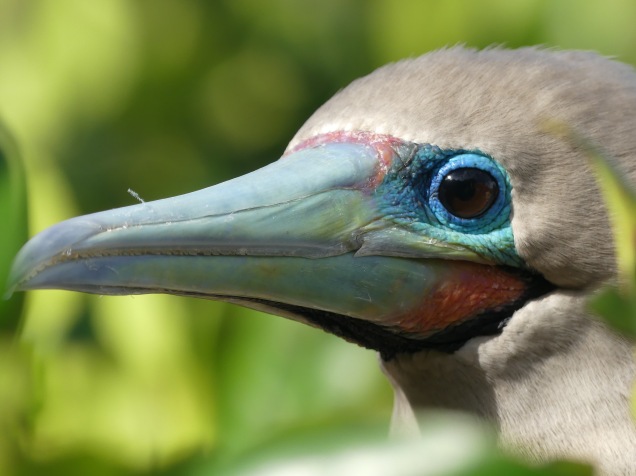

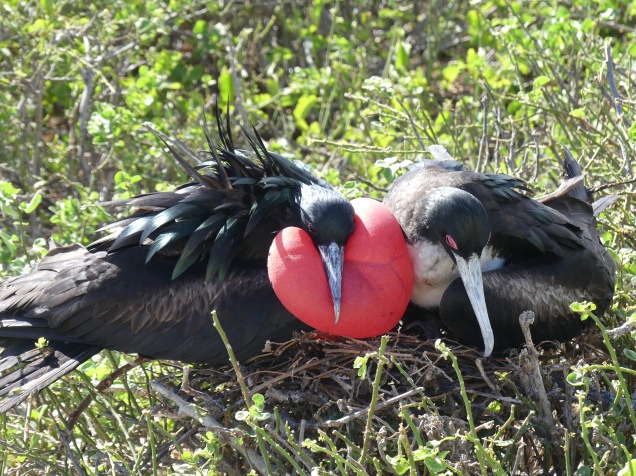
Top of the tree
As a raptor enthusiast, I was thrilled to see the majestic Galapagos hawk, which is thriving because it has no predators on these islands, feeding mostly on carrion, including one large female whom we first spotted on Santiago tucking into a dead sealion on the rocks, but then soon after flew to a nearby dead branch at the top of a tree to clean her talons. Boobies, turtles, sea lion cubs notwithstanding, I think she provided one of my favourite photos of the trip!
Dragons frozen in time
The prehistoric looking marine iguanas, the world’s only sea going lizard, were everywhere but most prolific when we visited Punta Espinoza on Fernandina island. Here, literally hundreds all piled together, climbing on top of each other to increase their body temperature, seemingly impassive to our presence, occasionally spitting to rid themselves of excessive salt. With their horny heads, dragon like spiky spines and scaly lips, they hardly moved when basking in the sun and almost seemed frozen in time. On most islands they were almost completely black, except for grey-green horny patches and spines, but the Española iguanas sport a cool tie-dyed red and green scaly effect, which gets more brilliant in mating season amongst the males. It was eerie to see the carcasses of dead iguanas, effectively dried out and mummified by the hot sun in the same stances as they had lived, slowly reducing to skeletons of their former selves. The land iguanas were equally dragonlike, but much more flamboyantly coloured in orange with green tinges
.




A life aquatic
Back in the water, snorkelling was always a fun adventure and window into another aspect of the Galápagos amazing biodiversity. I saw more fish species than I could possibly name, including king angelfish, bunpheads, rainbow parrotfish, pufferfish as well as diamond stingrays, mobular rays, eagle rays and golden rays during snorkelling and panga excursions, but we were also able to get up close and personal with enormous green turtles, especially in Tagus Cove on Isabela’s west coast opposite Fernandina, where at one point there were so many turtles around me, I didn’t know what direction to swim in! It was here too that two Galápagos penguins came to play with us in the water, darting at great speed around us, vanishing and reappearing with startling agility.
(Underwater pics courtesy of Carla & Arjen)


Seeing sharks while snorkelling had a particular thrill, and we saw many, from tiny young black tipped reef sharks in the shallows of Tortuga Bay near Puerto Ayora, to the medium sized white tipped sharks we saw lurking on the seabed at Puerto Egas on Santiago, but the highlight was the deep sparkling blue waters at Leon Dormido or Kicker Rock, just off San Cristobal, where far below us we could see both Galápagos sharks and hammerheads of varying sizes weaving smoothly through the waters. It truly sent a shiver down my spine!
Up close and personal
Another bird that seemed to like to get up close and personal with us came as a surprise. The Galápagos is home to the flightless cormorant, which joins penguins as the world’s only flightless seabirds. Now confined to these isles by its own evolution, the stubby raggy nature of its wings was clear to see. It has startlingly blue eyes, in contrast to its rather dull brown plumage. But in the water it certainly holds its own. We are taking a panga ride trip along the bottom of the cliffs on Punta Vicente Roca, where I’m enthralled by my first sightings of blue footed boobies perching on narrow rock ledges, when a cormorant decides to check out my foot trailing in the water with its beak! I yelp in shock, and Miguel, the ship’s first mate, is in stitches for the rest of the ride!


Later, at Tagus Cove, we meet a crazy cormorant whilst snorkelling, that starts to grab our wet suit zip cords, or any protruding limbs! As I’m filming these goings on, it makes a grab for my GoPro too, resulting in an interesting chaotic end to that clip! Let me know if you want to see it!
The friendliness and proximity of sealions, both in and out of the water, was also an ongoing joy through the trip. From the tiny newborn pup found all alone (the mothers typically leave their precocious offspring on shore for a few days after giving birth to go and feed up), to the youngsters that loved to play with us as we snorkelled, twisting and somersaulting around us, to the opportunistic females and big old bulls that were on harbour walls, benches, and around the fish stalls, they were a constant entertainment.

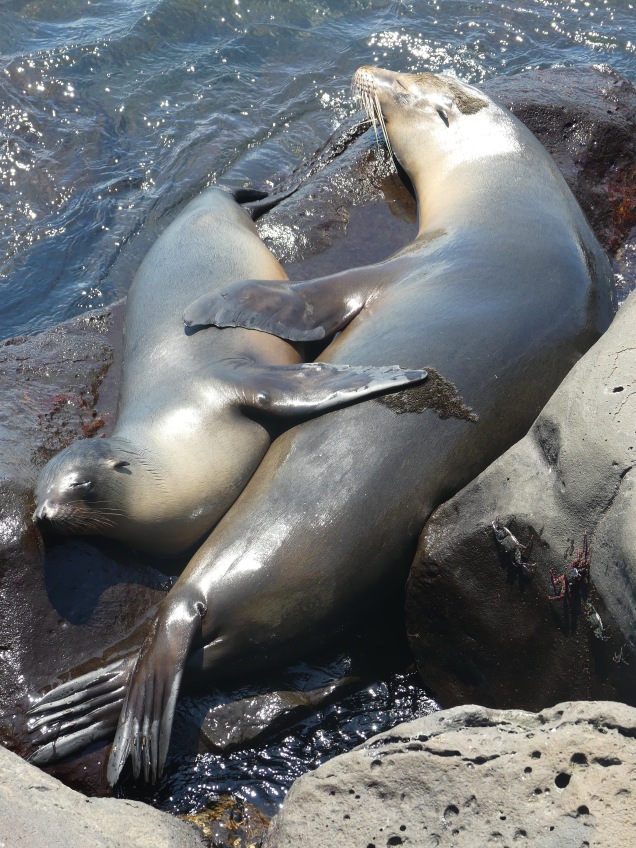

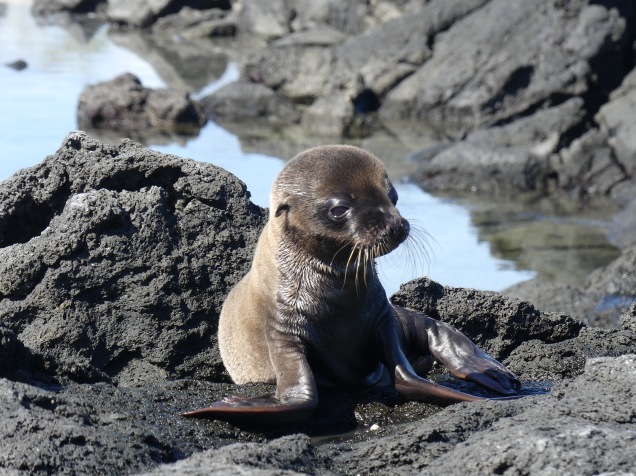
Saved from extinction
There are not many locations where you can see giant tortoises genuinely in the wild, as most of the places where they now roam on the sides of volcanoes are off limits for tourists, but we landed at Urbina Bay below Volcan Alcedo in a big sea swell and heavy rain and met four tortoises lumbering slowly along the paths, munching on plants, their gigantic gorgeous shells gleaming in the rain.


On Española, there were just 14 tortoises left at one point, twelve females and two males, which were taken to the Charles Darwin centre on Santa Cruz in an effort to save them. The males were initially reluctant to mate, until a global search yielded another male from San Diego Zoo, who then helped trigger breeding. The original tortoises are living out their days still at the centre, but over 2000 of their offspring are now back on Española, in a now self sustaining population. I felt conflicting emotions at the tortoise breeding centre at Puerto Villamil, where in barren dusty enclosures elderly males heaved themselves onto the backs of ambivalent females, but there is no doubt of the importance of its work, from the scarred shells of the surviving giant tortoises rescued from the eruption of Volcan Cerro Azul back in 1998, to the hundreds of small offspring slowly getting to the point of maturity when they can be released back into the wild. Looking at poor old lonesome George, famous as the last remaining Pinta island tortoise who lived for 120 years but never bred as no mate was ever found, and whose preserved body is now a rather sad looking exhibit behind glass at the Charles Darwin centre, made me value the work of the breeding centres even more.



For every conservation success however, there remain massive challenges for other species. Of urgent concern in the Galápagos bird world is the mangrove finch, one of thirteen Darwin’s finch species, of which only 200 breeding pairs remain, with nests now under attack from an invasive parasitical fly, phylornis downsi. I didn’t see this bird, as we were not allowed to land near the mangroves it still breeds in, but I did see several dark grey lava gulls, another endemic species to the Galapagos, of which it is believed only 400 pairs now remain. I’m pleased now to be a member of the Galapagos Conservation Trust who are supporting various ongoing work to protect vulnerable species of both flora and fauna.
Mates for life?
On my last full day, with Carla and Arjen from the cruise, I took a trip to see the waved albatrosses on Española, where these huge birds had just arrived back for mating season, and were courting in a clownish dance of bows and beak slapping. We watched enthralled as one pair had a clumsy attempt at mating (video clip here!), and there was already evidence of egg laying. Oddly, they do not build nests but lay randomly, then roll the single egg to a suitable brooding spot on the ground. We also witnessed evidence of abandoned eggs, which we were told by guide Loli would most likely be a female in her first breeding season, not quite getting it right, or possibly not trusting her mate to come back to her after several days’ absence fishing, and leaving her egg unprotected. Albatrosses live for around 60 years, and for as long as their partners are living, they mate for life.
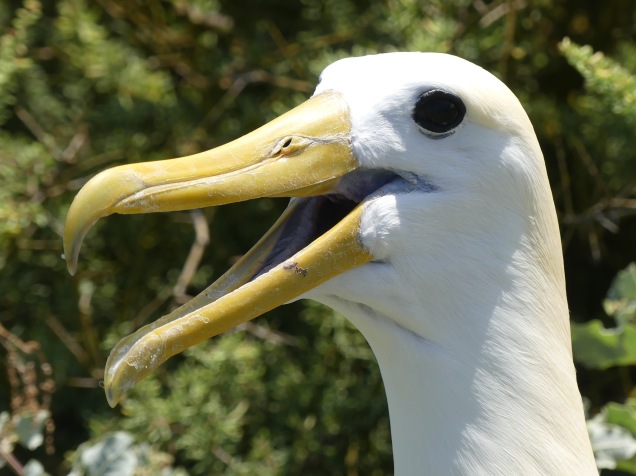


Kings of the Sea
Navigating between the islands gave us plenty of time for more wildlife spotting. I loved watching the storm petrels tap dancing on the surface of the waves, and the shearwaters skimming them, the odd pop up of the head of a a turtle or sealion and the double finned appearance of an eagle ray. We never had a much sought after pod of dolphins leaping around the boat, but we did have a few other special moments. The large mobular ray performing a series of spectacular double flip leaps out of the water in an acrobatic effort to rid itself of attached parasites had us all chanting “just one more”, and we also had occasional sightings of giant manta rays, a tantalisingly fleeting glimpse of a whale shark fin, and some distant dolphins leaping. But the crowning moment was the pod of five orcas – seemingly male, female and three offspring of varying size whom we spotted as we were approaching the north coast of Isabela. They generously gave us time to launch the pangas into the blessedly calm waters, and then circled around us before heading back out into the ocean, often breaching the surface in perfectly synchronised and majestic fashion – a truly wondrous moment I will treasure and remember for years to come.


Thanks to: the crew of Beagle and Jan our expert naturalist on board, I’d recommend you guys every time; to guide Loli and crew of Scuba Eden for the fab day trip to Española; to Rachel at Think Galapagos in the UK for advice and suggesting the Beagle – you were 100% right; to all my fellow “Beagly, Beagly” family who were such good fun, but especially Carla and Arjen, who were constant companions through the whole trip, generously shared their photos and videos of special moments, and have some lovely blogs (in Dutch) and wonderful photos at www.longwhitecloud.nl


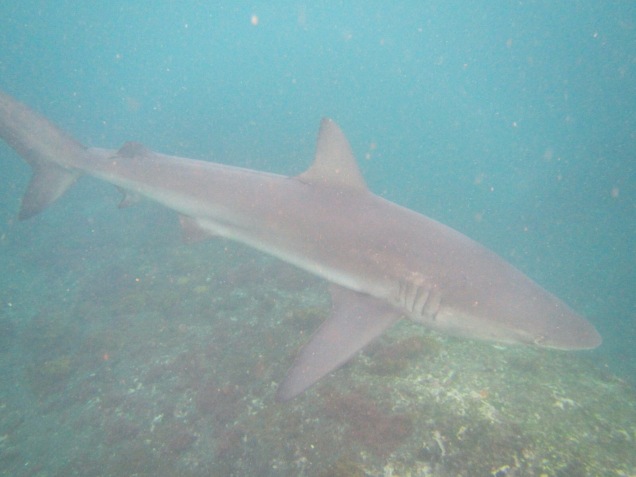

Fab blog Barbs. I’m also well and truly enchanted! Your photos are amazing.
Im so glad the trip is living up to/ exceeding expectations.
Mum and I had a smaller scale albeit delightful pleasure in a flotation bath at Barnsdale.
LikeLike
Thanks Julie! How were the ospreys?
LikeLike
Still not one osprey?
That is a truly magnificent account of your adventure. I hope some national newspaper is going to serialise it for you.
LikeLiked by 1 person
Thanks Tiger! When I was in Paracas in Peru, in the reserve one of the boards said they do have visiting ospreys! I got very excited, asks the guide where they could be found, and looked really hard, but not one in sight! I don’t think they’re very common there…
LikeLike
Barbara, you’ve really surpassed yourself this time. A fascinating blog and such wonderful photos. I also thought you might like to know that Clarach, Blue2R(13) has just laid her first egg at 17.30 BST on her nest at Aberfoyle. Grandchicks for Monty and Glesni – yay!
LikeLiked by 1 person
Thanks Sue!
LikeLike
What a lovely read that instantly brings back amazing memories!
LikeLike
Thanks Carla! I just read your latest one too, really good and love all the photos!
LikeLike